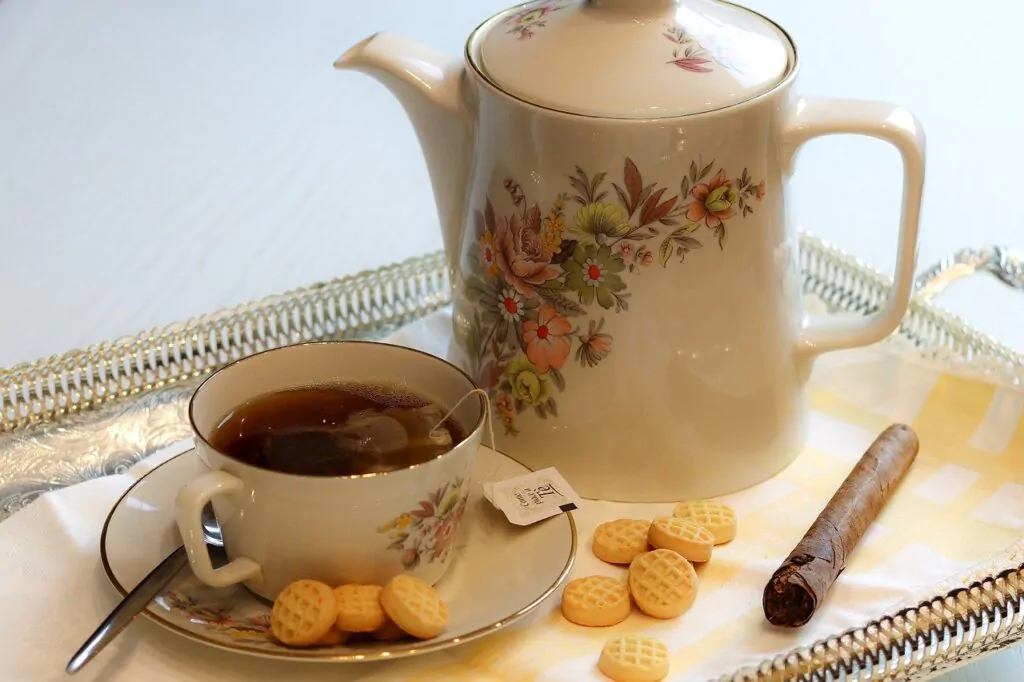Can you reuse teabags? Yes, depending on a few factors. So, how many times can you use a tea bag? And for anything besides brewing tea? We’ve got some suggestions.

For most people, tea bags are a use-em-and-chuck-em bit of daily sustenance.
However, good quality tea can last through the second round of use. If you’re just making one cup of tea at a time, there is no reason to toss a good teabag after one cup.
All kinds of tea can be re-steeped: Green tea, black tea, white tea, oolong tea, and even some herbal teas can be used a second time.
Here’s how to do it.
Making A Single Cup
Making a single cup of tea is a common practice when a tea drinker lives or works alone. It’s faster and easier than making an entire teapot which will just go cold before you’re ready for another cup.
If you prefer to make cups of tea one at a time, it’s more convenient to use a cup with a saucer and a tea bag or loose tea leaves placed into an infuser.
After steeping, you can place the tea bag or infuser onto your saucer to make another cup in an hour or two.
If you’re making milk tea, you’ve two choices.
Add the milk after you’ve removed your teabag. This method keeps the proteins in the milk from combining with the tannins of the tea. This can affect how well it will brew a second cup.
Your second infusion will be weaker than your first, but that’s ok. Give it a slightly longer steeping time and it will taste fine
On the other hand, adding the milk first prevents uneven heating but it’s harder to reuse the teabag as it will be milky.
Confused? It’s kind of like the Oxford comma. It’s down to personal preference and house style.
Fun fact: It’s a British tradition to add milk first before tea and hot water.
Making An Entire Pot

If you’re making a whole pot, standard practice is to use one teabag per cup of water, or 1 teaspoon of loose leaf tea per cup plus an extra for the pot. Then you steep for about 5 minutes.
That tea doesn’t have to go to waste!
After the first infusion, lift the lid and remove the bags using a clean spoon. Pile them onto a saucer or into a shot glass and set them aside.
They can be used to brew a second pot later in the day; like brewing a single cup, a second pot will be a bit weaker than the first so let them sit in the hot water for slightly longer, maybe 6 minutes.
A longer brew time has the added benefit of bringing out more of the health-giving properties of the tea leaves.
How Many Times Can You Use A Tea Bag?
We don’t recommend reusing a tea bag more than once. A third attempt will result in extremely weak tea, almost tasteless, and don’t keep used tea bags for more than 24 hours.
After that, they may begin to develop mold or an unpleasant smell.
If you prefer to drink tea in the morning and evening, you can reuse tea bags too. Cover the bags tightly so they don’t dry out or absorb other flavors and chill them overnight.
If you just have one bag, suspend it in a tiny bit of cold water in a shot glass. Multiple bags should be placed in a very small, airtight container with just enough water to keep them moist.
They’re fine at room temperature for a couple of hours, but any more time than that and you’ll want to pop them into your fridge to preserve their flavor.
Don’t Toss Tea Bags After A Single Use
If you enjoy drinking tea, there’s no reason to discard a tea bag after one use. You can use the same bag twice, and get the health benefits, including antioxidants, catechins, and polyphenols in both steepings.
It’s also a good idea to come up with other uses for your tea after it’s been steeped once or twice in boiling water.

This helps you stretch your money and get more bang for your buck, especially if you like more pricey teas.
The Last Word In Reusing Tea Bags
Tea is a natural product that will biodegrade quickly with no unpleasant effects on the environment, so toss your used tea bags or leaves onto a compost pile if you have one, tea leaves are full of nitrogen which is great for composting.
Loose-leaf tea can simply be tossed on the pile. Bags should be cut open and the leaf bits are shaken onto the pile. Discard the bags in the garbage. Many tea bags have small amounts of polypropylene woven into the fabric for strength, which is plastic and doesn’t decompose.
Drinking tea can be a regular part of a sustainable lifestyle. Get the most out of your tea habit!
How Many Times Can You Reuse A Teabag FAQs
Are used teabags good for anything?
Yes! After you’ve made tea with them twice, they still have value in other ways throughout your home.
1. Make a third pot of weak tea using your bags, let it cool to room temperature, then spray it over houseplants to protect them from fungal infections. Loose leaves can be spread around the base of your plants to fertilize the soil.
2. Chill the bags, then place them over dark circles under your eyes to relieve puffiness and irritation.
3. Drop a few old tea bags into the bottom of your garbage can to help eliminate odors.
What can I do with leftover brewed tea?
Leftover cold tea has several uses.
First, you can always heat it back up to drink again, as long as it’s not too old. If it’s been sitting out for 24 hours, make a fresh pot to drink and use the leftovers for something else. If it’s been in the fridge, dissolve a little sugar in it and make iced tea.
You can pour it over tropical houseplants, who prefer acidic soil; they love the tannic acid in old tea. Or you can use it in a marinade for meat; the acidity helps break down muscle fibers.

